You are using an out of date browser. It may not display this or other websites correctly.
You should upgrade or use an alternative browser.
You should upgrade or use an alternative browser.
Skripal Case Bombshell: Swiss Lab Reports 'BZ Toxin' Used In Salisbury - Chemical Not Produced In Russia, Only NATO States
- Thread starter Bastian
- Start date
Story was going cold so a need to raise it again ? Keeping all the plates spinning to keep us distracted and confused.
Вот здесь я вынужден с вами не согласиться. Я, как представитель "авторов новичка" и как " хакер, вмешивающийся во все подряд выборы" хочу, чтобы все эти "тарелки крутились", как вы говорите. Причем, крутиться эти тарелочки должны там, где их запустили ибо мы и так хорошо помним все эти плевки в наш адрес. Только тогда, когда никто не будет забывать, при возникновении новой оказии (а они безусловно будут возникать), можно будет спросить: как там дела с расследованием сбитого на Донбассе боинга, дела Скрипалей, вмешательство в американские выборы и т.д. Але, господин Мюллер?Story was going cold so a need to raise it again ? Keeping all the plates spinning to keep us distracted and confused.
Translation
I, as a representative of "novichok authors" and as a "hacker interfering in all elections" want all these "plates spinning" as you say. Moreover, spin those plates mostly there, where they started because we well remember all those spitting in our address. Only when no one will forget, in the event of a new event (and they will certainly arise), it will be possible to ask: how are things with the investigation of the Boeing shot down in the Donbass, the case of Skripals, interference in the American elections, etc. How you succeed, Mr. Muller?
Вот здесь я вынужден с вами не согласиться. Я, как представитель "авторов новичка" и как " хакер, вмешивающийся во все подряд выборы" хочу, чтобы все эти "тарелки крутились", как вы говорите. Причем, крутиться эти тарелочки должны там, где их запустили ибо мы и так хорошо помним все эти плевки в наш адрес. Только тогда, когда никто не будет забывать, при возникновении новой оказии (а они безусловно будут возникать), можно будет спросить: как там дела с расследованием сбитого на Донбассе боинга, дела Скрипалей, вмешательство в американские выборы и т.д. Але, господин Мюллер?
Translation
I, as a representative of "novichok authors" and as a "hacker interfering in all elections" want all these "plates spinning" as you say. Moreover, spin those plates mostly there, where they started because we well remember all those spitting in our address. Only when no one will forget, in the event of a new event (and they will certainly arise), it will be possible to ask: how are things with the investigation of the Boeing shot down in the Donbass, the case of Skripals, interference in the American elections, etc. How you succeed, Mr. Muller?
I agree with you youlik. Even though is seems "the programming is complete" those of us who are aware of the "false flags" need to never forget. I think those of us who see the propaganda for what it is do get weary that the truth just remains covered up due to all the programming. My head feels like it's "spinning" a lot these days.
Thanks for the reminder.
angelburst29
The Living Force
Yulia Skripal’s sister, Viktoria, plans to contact the Russian authorities and file a missing person report.
Jan. 29, 2019 - Russian embassy comments on intention of Skripals' relative to file missing person report
Russian embassy comments on intention of Skripals' relative to file missing person report
The Russian Embassy in the UK understands the intention of Yulia Skripal’s sister, Viktoria, to contact the Russian authorities and file a missing person report, the embassy stated on Tuesday.
"The embassy deeply understands Viktoria Skripal’s cry for help, as to this day, we have no information regarding the fate and health of her relatives - Sergei and Yulia. We have to state that a year after the events in Salisbury, the British officials and law enforcement agencies still have not provided any official results of the ongoing investigation of this incident.
Multiple requests of the Russian side to cooperate in the investigation of the poisoning of our citizens have been left without a response, and the investigation is carried out in the atmosphere of total secrecy. In violation of the 1963 Vienna Convention on Consular Relations and the bilateral Consular Convention of 1965, the representatives of the embassy have not been provided access to the Russian citizens to this day, first and foremost to ensure that they are alive and well, and that they are not under pressure."
The embassy stressed that Viktoria Skripal’s intention "once again disproves the statements of British officials claiming that Sergei and Yulia Skripal are not in isolation and are in contact with their relatives and friends."
Jan. 29, 2019 - Russian embassy comments on intention of Skripals' relative to file missing person report
Russian embassy comments on intention of Skripals' relative to file missing person report
The Russian Embassy in the UK understands the intention of Yulia Skripal’s sister, Viktoria, to contact the Russian authorities and file a missing person report, the embassy stated on Tuesday.
"The embassy deeply understands Viktoria Skripal’s cry for help, as to this day, we have no information regarding the fate and health of her relatives - Sergei and Yulia. We have to state that a year after the events in Salisbury, the British officials and law enforcement agencies still have not provided any official results of the ongoing investigation of this incident.
Multiple requests of the Russian side to cooperate in the investigation of the poisoning of our citizens have been left without a response, and the investigation is carried out in the atmosphere of total secrecy. In violation of the 1963 Vienna Convention on Consular Relations and the bilateral Consular Convention of 1965, the representatives of the embassy have not been provided access to the Russian citizens to this day, first and foremost to ensure that they are alive and well, and that they are not under pressure."
The embassy stressed that Viktoria Skripal’s intention "once again disproves the statements of British officials claiming that Sergei and Yulia Skripal are not in isolation and are in contact with their relatives and friends."
angelburst29
The Living Force
Just one of those little things - not important?
British Prime Minister Theresa May's office posted a picture of the wrong English city when it sought to mark the anniversary of the poisoning of a former Russian double agent that London has blamed on the Kremlin.
Wrong spire: UK PM May's office gets wrong city on anniversary of spy poisoning
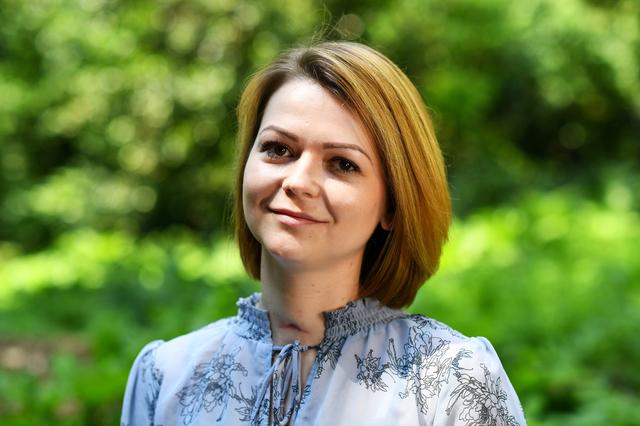
Over a picture of green trees, a river and Bath’s spire, Theresa May’s twitter feed said: “Salisbury has fought back so well from such a devastating and reckless incident - a testament to the resolve, forbearance and positivity of the community.”
“This was an error which has now been rectified,” May said when asked about the picture on a visit to Salisbury Cathedral.
Former Russian spy Sergei Skripal, and his daughter Yulia, were found slumped on a public bench in the English city of Salisbury on March 4 last year, and Britain has charged two Russians in absentia with their attempted murder.
Russia has denied involvement in the poisoning, which sparked the biggest diplomatic expulsions since the height of the Cold War.
The two Russians accused by London of carrying out the poisoning for Russian military intelligence later told a television station that they had visited the city of Salisbury to see its famous cathedral spire.
“I’m here in the cathedral which is a great attraction, wonderful things to come and see,” May said in a televised interview.
“Salisbury is open for business. What I’ve seen today here in Salisbury is the tremendous spirit and resolve of the people of Salisbury. It’s been a difficult year for them.”
May’s tweet with the picture of Bath, a nearby city known for its Roman-built baths, was later changed to show a picture of her Downing Street office.
The prime minister has two twitter accounts. A spokesman for the prime minister said the wrong picture was used following a human error and was corrected as soon as possible.
British Prime Minister Theresa May's office posted a picture of the wrong English city when it sought to mark the anniversary of the poisoning of a former Russian double agent that London has blamed on the Kremlin.
Wrong spire: UK PM May's office gets wrong city on anniversary of spy poisoning
Over a picture of green trees, a river and Bath’s spire, Theresa May’s twitter feed said: “Salisbury has fought back so well from such a devastating and reckless incident - a testament to the resolve, forbearance and positivity of the community.”
“This was an error which has now been rectified,” May said when asked about the picture on a visit to Salisbury Cathedral.
Former Russian spy Sergei Skripal, and his daughter Yulia, were found slumped on a public bench in the English city of Salisbury on March 4 last year, and Britain has charged two Russians in absentia with their attempted murder.
Russia has denied involvement in the poisoning, which sparked the biggest diplomatic expulsions since the height of the Cold War.
The two Russians accused by London of carrying out the poisoning for Russian military intelligence later told a television station that they had visited the city of Salisbury to see its famous cathedral spire.
“I’m here in the cathedral which is a great attraction, wonderful things to come and see,” May said in a televised interview.
“Salisbury is open for business. What I’ve seen today here in Salisbury is the tremendous spirit and resolve of the people of Salisbury. It’s been a difficult year for them.”
May’s tweet with the picture of Bath, a nearby city known for its Roman-built baths, was later changed to show a picture of her Downing Street office.
The prime minister has two twitter accounts. A spokesman for the prime minister said the wrong picture was used following a human error and was corrected as soon as possible.
angelburst29
The Living Force
Russia’s Ambassador to London Alexander Yakovenko has suggested a meeting with the son of the British woman who died from the nerve agent poisoning in Amesbury, in order to answer any question that the man might have, the Russian embassy to the UK said on Wednesday.
March 7, 2019 - Russian ambassador to UK suggests meeting with Novichok victim’s son
Russian ambassador to UK suggests meeting with Novichok victim’s son
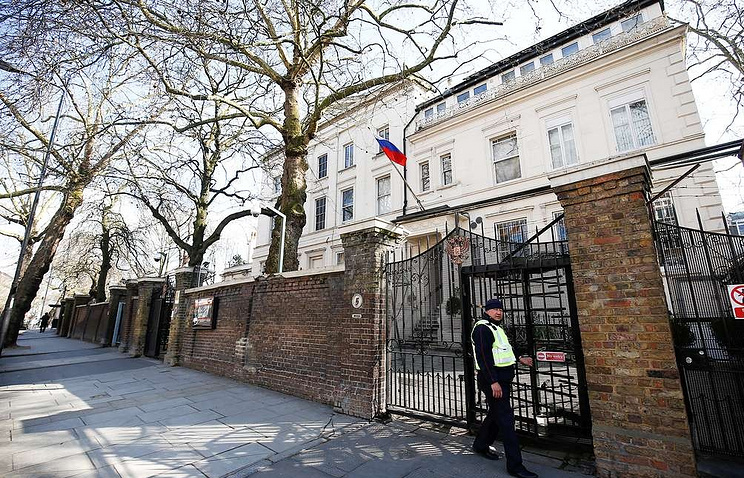
Russian embassy in London © REUTERS/Henry Nicholls
Ewan Hope, 20, is one of Dawn Sturgess’ three children.
"Today on March 6th, through the ‘Sunday Mirror’ editorial office, the Embassy received a copy of the letter addressed to the President of Russia Vladimir Putin from Ewan Hope, son of the late Dawn Sturgess, regarding the circumstances of his mother’s death," the embassy said in a press release.
"Ambassador Yakovenko has sent Mr. Hope a reply, in which he has expressed his condolences on the tragic death of Ms. Sturgess and proposed a meeting to answer in person to any questions that Mr. Hope might have," the press release says.
"The letter was accompanied by the report ‘Salisbury: Unanswered Questions’ on the key elements of the events one year ago, published by the Embassy on March 3rd 2019," it added.
In an interview with the latest issue of the Sunday Mirror, Ewan Hope, 20, one of Dawn Sturgess’ three children, said that he "felt betrayed and let down by the Government." He also accused the British government of offering no support. The daily published his letter to Vladimir Putin in which he asks the Russian president to "allow our officers to question" the suspects "about my mum’s murder." "The least she deserves is justice," he said in the letter.
[...] On June 30, 2018 Dawn Sturgess, 44, and Charles Rowley, 45, were hospitalized in critical condition in the British town of Amesbury, Wiltshire County. Sturgess was reported to have died in hospital on July 8, while Rowley was discharged from the hospital on July 20. In middle August he was again admitted to hospital after complaining of vision problems.
The Organization for the Prohibition of Chemical Weapons (OPCW) said in its report on September 4 that Dawn Sturgess died after being exposed to the same nerve agent that had been allegedly used in the March attack on Sergei and Yulia Skripal in neighboring Salisbury.
British Prime Minister Theresa May on September 5 briefed Parliament on progress in the investigation to declare that two Russians carrying passports issued in the names of Alexander Petrov and Ruslan Boshirov were the suspected attackers. British special services claimed that both were GRU agents. Then men were interviewed on the RT television channel to dismiss the speculations as preposterous.
March 7, 2019 - Russian ambassador to UK suggests meeting with Novichok victim’s son
Russian ambassador to UK suggests meeting with Novichok victim’s son

Russian embassy in London © REUTERS/Henry Nicholls
Ewan Hope, 20, is one of Dawn Sturgess’ three children.
"Today on March 6th, through the ‘Sunday Mirror’ editorial office, the Embassy received a copy of the letter addressed to the President of Russia Vladimir Putin from Ewan Hope, son of the late Dawn Sturgess, regarding the circumstances of his mother’s death," the embassy said in a press release.
"Ambassador Yakovenko has sent Mr. Hope a reply, in which he has expressed his condolences on the tragic death of Ms. Sturgess and proposed a meeting to answer in person to any questions that Mr. Hope might have," the press release says.
"The letter was accompanied by the report ‘Salisbury: Unanswered Questions’ on the key elements of the events one year ago, published by the Embassy on March 3rd 2019," it added.
In an interview with the latest issue of the Sunday Mirror, Ewan Hope, 20, one of Dawn Sturgess’ three children, said that he "felt betrayed and let down by the Government." He also accused the British government of offering no support. The daily published his letter to Vladimir Putin in which he asks the Russian president to "allow our officers to question" the suspects "about my mum’s murder." "The least she deserves is justice," he said in the letter.
[...] On June 30, 2018 Dawn Sturgess, 44, and Charles Rowley, 45, were hospitalized in critical condition in the British town of Amesbury, Wiltshire County. Sturgess was reported to have died in hospital on July 8, while Rowley was discharged from the hospital on July 20. In middle August he was again admitted to hospital after complaining of vision problems.
The Organization for the Prohibition of Chemical Weapons (OPCW) said in its report on September 4 that Dawn Sturgess died after being exposed to the same nerve agent that had been allegedly used in the March attack on Sergei and Yulia Skripal in neighboring Salisbury.
British Prime Minister Theresa May on September 5 briefed Parliament on progress in the investigation to declare that two Russians carrying passports issued in the names of Alexander Petrov and Ruslan Boshirov were the suspected attackers. British special services claimed that both were GRU agents. Then men were interviewed on the RT television channel to dismiss the speculations as preposterous.
angelburst29
The Living Force
April 7, 2019 - Survivor of Novichok nerve agent attack meets Russian ambassador in London
Russian ambassador to Novichok nerve agent attack survivor: Moscow not responsible as not all victims died

British police guarding the tarpaulin-covered former home of Russian ex-spy Sergei Skripal in Salisbury, on March 4, 2019.PHOTO: AFP
Moscow could not be behind last year's nerve agent attack in the British city of Salisbury because not all of the victims died, the Russian ambassador has told one survivor, according to the Sunday Mirror.
The paper arranged for Mr Charlie Rowley to meet Ambassador Alexander Yakovenko on Saturday (April 6).
Mr Rowley's partner Dawn Sturgess died after handling a perfume bottle that had apparently held the nerve agent Novichok and which was used to attack ex-spy Sergei Skripal and his daughter, Yulia on March 4, 2018. Mr Skripal and his daughter survived.
Mr Rowley, who had found the perfume bottle months after the attack and gave it to his girlfriend, also survived but spent 10 days in a coma and has ongoing health problems including loss of eye sight.
"I went along to ask them, 'Why did your country kill my girlfriend?' But I didn't really get any answers. I just got Russian propaganda," he told the Mirror.
"I liked the ambassador, but I thought some of what he said trying to justify Russia not being responsible was ridiculous... The ambassador kept saying the substance definitely wasn't the Novichok they had made because if it was it would have killed everyone."
Britain has accused two officers from Russia's military intelligence agency, the GRU, of being responsible for the poisonings.
The two men claimed in an interview with Russia's state broadcaster RT that they were visiting Britain as tourists and wanted to see Salisbury Cathedral and the nearby Stonehenge prehistoric monument.
Russian ambassador to Novichok nerve agent attack survivor: Moscow not responsible as not all victims died

British police guarding the tarpaulin-covered former home of Russian ex-spy Sergei Skripal in Salisbury, on March 4, 2019.PHOTO: AFP
Moscow could not be behind last year's nerve agent attack in the British city of Salisbury because not all of the victims died, the Russian ambassador has told one survivor, according to the Sunday Mirror.
The paper arranged for Mr Charlie Rowley to meet Ambassador Alexander Yakovenko on Saturday (April 6).
Mr Rowley's partner Dawn Sturgess died after handling a perfume bottle that had apparently held the nerve agent Novichok and which was used to attack ex-spy Sergei Skripal and his daughter, Yulia on March 4, 2018. Mr Skripal and his daughter survived.
Mr Rowley, who had found the perfume bottle months after the attack and gave it to his girlfriend, also survived but spent 10 days in a coma and has ongoing health problems including loss of eye sight.
"I went along to ask them, 'Why did your country kill my girlfriend?' But I didn't really get any answers. I just got Russian propaganda," he told the Mirror.
"I liked the ambassador, but I thought some of what he said trying to justify Russia not being responsible was ridiculous... The ambassador kept saying the substance definitely wasn't the Novichok they had made because if it was it would have killed everyone."
Britain has accused two officers from Russia's military intelligence agency, the GRU, of being responsible for the poisonings.
The two men claimed in an interview with Russia's state broadcaster RT that they were visiting Britain as tourists and wanted to see Salisbury Cathedral and the nearby Stonehenge prehistoric monument.
angelburst29
The Living Force
Rowley met earlier with British Prime Minister Theresa May, tried to sort out the situation and, as he put it, noted that he was not satisfied with the conversation.
April 7, 2019 - Russian embassy confirms that Charles Rowley has requested a meeting with Putin
Russian embassy confirms that Charles Rowley has requested a meeting with Putin
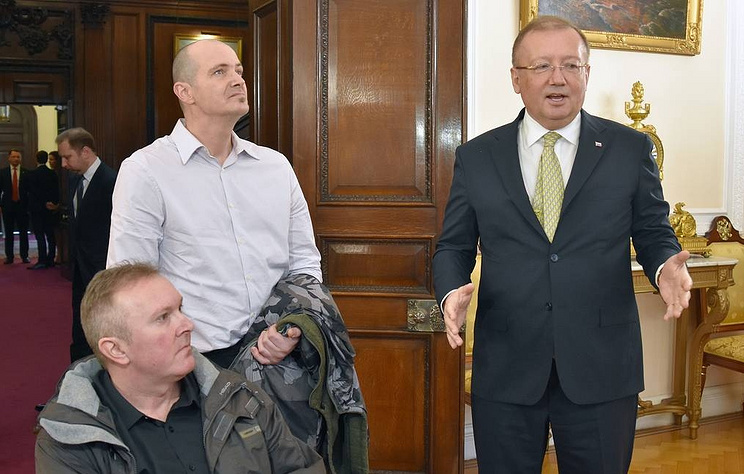
Matthew Rowley, Charles Rowley and Russia’s Ambassador Alexander Yakovenko © Ilya Dmitryachev/TASS
Russia’s embassy in Britain has confirmed that the British national Charles Rowley who Scotland Yard says was exposed to a 'Novichok-class' nerve agent last summer, asked Russia’s Ambassador Alexander Yakovenko for a meeting with President Vladimir Putin, a representative of the embassy told TASS when asked to comment on Rowley’s statements regarding the issue.
"Charles Rowley met earlier with British Prime Minister Theresa May, tried to sort out the situation and, as he put it, noted that he was not satisfied with the conversation. His wish to meet President Putin is related to his intention to understand what happened," the representative said. "Having failed to elicit truth from Theresa May, he wants to find it in a conversation with Russian President," the diplomat said, adding that it was the wish to sort out the details of what happened that has become one of the main reasons for Rowley’s meeting with Yakovenko.
The focus of the discussion, which was initiated by Charles Rowley and his brother Matthew, was on the events around the alleged poisoning of Russia’s former military intelligence officer Sergei Skripal and his daughter Yulia in Salisbury in Salisbury in March 2018, as well as Rowley himself and his friend Dawn Sturgess in Amesbury in June 2018.
Yakovenko outlined in detail Moscow's view on what happened in Salisbury and Amesbury, and emphasized that the numerous requests from the Russian side to the British authorities mostly remain unanswered.
Following the meeting, Charlie Rowley said in an interview with the British newspaper Sunday Mirror that he had asked Russia’s ambassador to organize a meeting with President Vladimir Putin for him. According to Rowley, the Russian diplomat replied that he would deliver the request.
April 7, 2019 - Russian embassy confirms that Charles Rowley has requested a meeting with Putin
Russian embassy confirms that Charles Rowley has requested a meeting with Putin

Matthew Rowley, Charles Rowley and Russia’s Ambassador Alexander Yakovenko © Ilya Dmitryachev/TASS
Russia’s embassy in Britain has confirmed that the British national Charles Rowley who Scotland Yard says was exposed to a 'Novichok-class' nerve agent last summer, asked Russia’s Ambassador Alexander Yakovenko for a meeting with President Vladimir Putin, a representative of the embassy told TASS when asked to comment on Rowley’s statements regarding the issue.
"Charles Rowley met earlier with British Prime Minister Theresa May, tried to sort out the situation and, as he put it, noted that he was not satisfied with the conversation. His wish to meet President Putin is related to his intention to understand what happened," the representative said. "Having failed to elicit truth from Theresa May, he wants to find it in a conversation with Russian President," the diplomat said, adding that it was the wish to sort out the details of what happened that has become one of the main reasons for Rowley’s meeting with Yakovenko.
The focus of the discussion, which was initiated by Charles Rowley and his brother Matthew, was on the events around the alleged poisoning of Russia’s former military intelligence officer Sergei Skripal and his daughter Yulia in Salisbury in Salisbury in March 2018, as well as Rowley himself and his friend Dawn Sturgess in Amesbury in June 2018.
Yakovenko outlined in detail Moscow's view on what happened in Salisbury and Amesbury, and emphasized that the numerous requests from the Russian side to the British authorities mostly remain unanswered.
Following the meeting, Charlie Rowley said in an interview with the British newspaper Sunday Mirror that he had asked Russia’s ambassador to organize a meeting with President Vladimir Putin for him. According to Rowley, the Russian diplomat replied that he would deliver the request.
That could put the cat among the pigeons!!!!
angelburst29
The Living Force
The English cathedral city of Salisbury, the location of a deadly nerve agent poisoning blamed on Russia, was named as Britain's best place to live by the Sunday Times newspaper.
April 14, 2019 - Salisbury, scene of Novichok poison drama, named Britain's best place to live
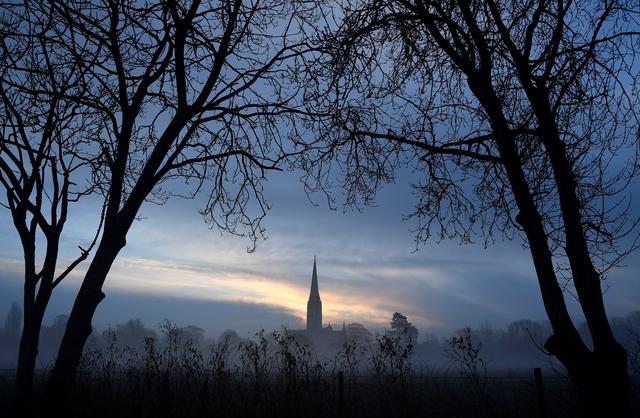
The award comes a little over a year after a former Russian double agent and his daughter were found slumped on a bench, triggering a sequence of events which ended with one person dead and the West’s relations with Russia in the diplomatic deep-freeze.
The Sunday Times praised the “divinely attractive” city in southern England, previously best-known for its medieval cathedral, citing its friendly atmosphere, good rail links and the high-speed broadband connections.
Whatever foes this beautiful medieval city has faced, from the Celts to the Vikings the recent Novichok poisonings, it has emerged victorious,” the newspaper wrote.
The paper said it had looked at statistics like crime, schools and property prices in reaching its judgment, but that the award had also been based on less easily-measured factors like “beautiful scenery, culture and, above all, community spirit.”
April 14, 2019 - Salisbury, scene of Novichok poison drama, named Britain's best place to live
The award comes a little over a year after a former Russian double agent and his daughter were found slumped on a bench, triggering a sequence of events which ended with one person dead and the West’s relations with Russia in the diplomatic deep-freeze.
The Sunday Times praised the “divinely attractive” city in southern England, previously best-known for its medieval cathedral, citing its friendly atmosphere, good rail links and the high-speed broadband connections.
Whatever foes this beautiful medieval city has faced, from the Celts to the Vikings the recent Novichok poisonings, it has emerged victorious,” the newspaper wrote.
The paper said it had looked at statistics like crime, schools and property prices in reaching its judgment, but that the award had also been based on less easily-measured factors like “beautiful scenery, culture and, above all, community spirit.”
angelburst29
The Living Force
Viktoria Skripal has come up with suggestions that after having her flat sold, Yulia will make a statement that she was not going to return to Russia.
Yulia Skripal puts her Moscow flat on sale, looks for new owner for her dog
May 18, 2019 - Yulia Skripal, the daughter of former GRU (military intelligence) Colonel Sergei Skripal allegedly poisoned in the UK, is not planning to return to Russia, as she has already had her car sold and has also put her Moscow flat on sale, Viktoria Skripal, Yulia’s cousin and Sergei’s niece, told TASS on Saturday.
"Yulia Skripal does not plan to come back to Russia, as she has already had her Ford car sold and now her two-room flat is on sale as well. They are looking for a buyer and it is not a secret. A friend of hers is authorized to sell her flat. She gets in touch with her friend on social networks," Viktoria said.
"A corner two-room flat is located on the first floor … in northwest Moscow, in Davydkovskaya Street. Yulia owns it and is registered there. Besides, Yulia asked to take care of her dog, a black mongrel called Nuar, so to find a good master for it," she added.
Until now, Viktoria has been taking care of Sergei Skripal’s 90-year-old mother.
"His mother’s health is volatile as granny will be 91 on July 24. It was last year when Yulia made only one - the first and last - call on her granny’s birthday," Viktoria said.
Viktoria Skripal has come up with suggestions that after having her flat sold, Yulia will make a statement that she was not going to return to Russia.
"She will have to make this statement so that I can calm down and will stop filing requests wherever possible," she assumed.
Yulia Skripal puts her Moscow flat on sale, looks for new owner for her dog
May 18, 2019 - Yulia Skripal, the daughter of former GRU (military intelligence) Colonel Sergei Skripal allegedly poisoned in the UK, is not planning to return to Russia, as she has already had her car sold and has also put her Moscow flat on sale, Viktoria Skripal, Yulia’s cousin and Sergei’s niece, told TASS on Saturday.
"Yulia Skripal does not plan to come back to Russia, as she has already had her Ford car sold and now her two-room flat is on sale as well. They are looking for a buyer and it is not a secret. A friend of hers is authorized to sell her flat. She gets in touch with her friend on social networks," Viktoria said.
"A corner two-room flat is located on the first floor … in northwest Moscow, in Davydkovskaya Street. Yulia owns it and is registered there. Besides, Yulia asked to take care of her dog, a black mongrel called Nuar, so to find a good master for it," she added.
Until now, Viktoria has been taking care of Sergei Skripal’s 90-year-old mother.
"His mother’s health is volatile as granny will be 91 on July 24. It was last year when Yulia made only one - the first and last - call on her granny’s birthday," Viktoria said.
Viktoria Skripal has come up with suggestions that after having her flat sold, Yulia will make a statement that she was not going to return to Russia.
"She will have to make this statement so that I can calm down and will stop filing requests wherever possible," she assumed.
angelburst29
The Living Force
May 24, 2019 - Skripal’s niece hands over recordings of his latest phone calls to Investigative Committee

Viktoria Skripal © Vladimir Gerdo/TASS
Viktoria Skripal, niece of former GRU officer Sergei Skripal, has handed over recordings of her uncle’s recent phone calls with her to the Russian Investigative Committee, she informed TASS on Friday.
"He has called twice, once in April and once he left a voicemail. <…> The phone number was identified, it’s a number registered in Great Britain, both times it has been different. <…> I have already handed over [the materials to the Russian Investigative Committee," she said.
She explained that it was her decision not to inform anyone of Sergei Skripal’s calls in the past. "It is my personal decision. <…> From the beginning, I decided that I wanted him to call and speak to the mother. He called," she noted.
The Russian Investigative Committee’s Directorate for the Yaroslavl Region informed TASS that they had not received any documents from Viktoria Skripal. "She may have sent them directly to the Central Administration of the Russian Investigative Committee," the source pointed out.

Viktoria Skripal © Vladimir Gerdo/TASS
Viktoria Skripal, niece of former GRU officer Sergei Skripal, has handed over recordings of her uncle’s recent phone calls with her to the Russian Investigative Committee, she informed TASS on Friday.
"He has called twice, once in April and once he left a voicemail. <…> The phone number was identified, it’s a number registered in Great Britain, both times it has been different. <…> I have already handed over [the materials to the Russian Investigative Committee," she said.
She explained that it was her decision not to inform anyone of Sergei Skripal’s calls in the past. "It is my personal decision. <…> From the beginning, I decided that I wanted him to call and speak to the mother. He called," she noted.
The Russian Investigative Committee’s Directorate for the Yaroslavl Region informed TASS that they had not received any documents from Viktoria Skripal. "She may have sent them directly to the Central Administration of the Russian Investigative Committee," the source pointed out.
angelburst29
The Living Force
New York Times article on Salisbury incident reveals manipulative techniques — embassy
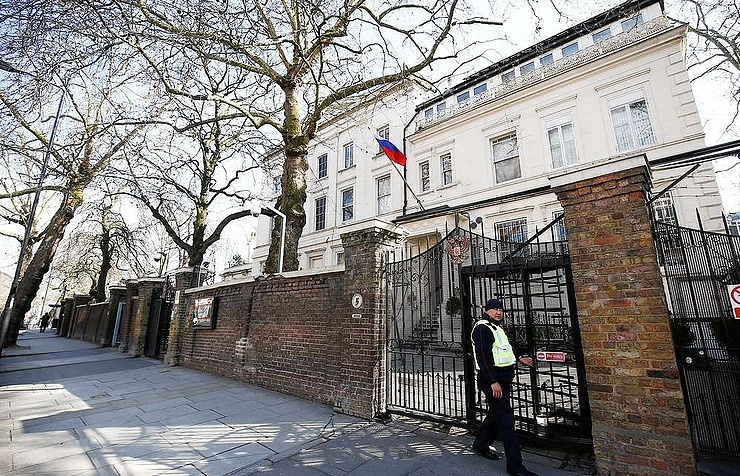
Russian Embassy in London © REUTERS/Henry Nicholls
LONDON, June 8, 2019 - Even after being corrected, a New York Times article about US President's reaction to the Salisbury incident clearly demonstrates how political decisions are made in the era of fake news, the Russian Embassy in London said late on Friday.
"Evidently, the newspaper realized that dissemination of overtly fake information harms the paper’s reputation. However, at the core, even the new version portrays the leadership of US special services in quite an unsavory light. The readiness to manipulate political leaders and the global public opinion has become one of their favorite techniques long ago," the embassy said.

Russian Embassy in London © REUTERS/Henry Nicholls
LONDON, June 8, 2019 - Even after being corrected, a New York Times article about US President's reaction to the Salisbury incident clearly demonstrates how political decisions are made in the era of fake news, the Russian Embassy in London said late on Friday.
"Evidently, the newspaper realized that dissemination of overtly fake information harms the paper’s reputation. However, at the core, even the new version portrays the leadership of US special services in quite an unsavory light. The readiness to manipulate political leaders and the global public opinion has become one of their favorite techniques long ago," the embassy said.
New York Times article
New York Times said in an article on April 16 that US President Donald Trump was initially reluctant to expel Russian diplomats in the wake of the Salisbury incident, but changed his mind after a conversation with CIA Director Gina Haspel. The paper claimed that the president was shown images, received from the United Kingdom, showing children allegedly hospitalized after being exposed to the Novichok nerve agent, and photographs of ducks poisoned with the same substance. Trump was reportedly stirred by the images and gave the green light to the toughest response.
On June 5, the paper corrected the article, saying that the CIA head "displayed pictures illustrating the consequences of nerve agent attacks, not images specific to the chemical attack in Britain." Although the paper admitted that some information the article was incorrect, it took it almost two months to clarify data.
"In 2003, Colin Powell [then UN Secretary of State] demonstrated the UN Security Council not actual samples of anthrax from Iraq, but just a vial that resembled a vial containing anthrax spores. In order to illustrate the so-called chemical attacks in Syria, TV airs footage (filmed by the White Helmets and funded by Western governments), demonstrating not children who were actually harmed, but just some children who look like children exposed to chemical weapons. In this case, too, Donald Trump was shown not photos of ducks, who died of poisoning in Salisbury, but just of some birds that look like birds killed by a chemical agent," the Russian diplomats said.
"All of this together creates a sad illustration of how major political decisions are made in the era of ‘fake news,’ ‘post-truth politics’ and ‘hybrid security,’" they said.
Skripal saga
According to London, former Russian military intelligence (GRU) Colonel Sergei Skripal, 66, who had been convicted in Russia of spying for Great Britain and later swapped for Russian intelligence officers, and his daughter Yulia, 33, suffered the effects of an alleged nerve agent in the British city of Salisbury on March 4. Claiming that the substance used in the attack had been a Novichok-class nerve agent developed in the Soviet Union, London rushed to accuse Russia of being involved in the incident. Moscow rejected all of the United Kingdom’s accusations, saying that neither the Soviet Union nor Russia ever had any program aimed at developing such a substance.
However, the UK expelled 23 Russian diplomats and announced other restrictive measures against Moscow without presenting any evidence of its involvement in the incident. In retaliation to the UK’s steps, Russia expelled 23 British diplomats, closed the British consulate general in the city of St. Petersburg, while the British Council had to shut down its operations in Russia.
In the wake of the Skripal incident, a number of EU member countries, the United States, Canada and Australia announced the expulsion of Russian diplomats. Washington expelled 60 diplomatic workers and closed the Russian consulate in Seattle.
The Russian Foreign Ministry later announced retaliatory measures against counties that had expelled Russian diplomats. In particular, Moscow expelled 60 US diplomats and closed the US consulate general in the city of St. Petersburg. The United Kingdom was requested to reduce the number of its diplomatic staff in Russia so that it would match the number of Russian diplomats in Great Britain.
angelburst29
The Living Force
Prime Minister Theresa May came face-to-face with President Putin at the G20 summit in Osaka, Japan.
UK PM May tells Putin to stop destabilizing activities: spokeswoman
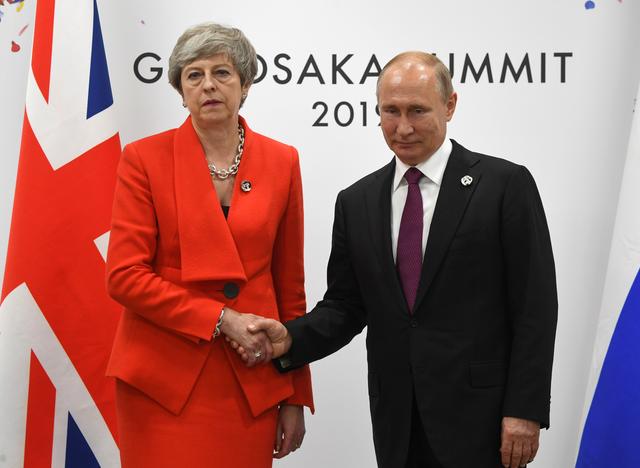
Prime Minister Theresa May told President Vladimir Putin on Friday that their countries can only have a different relationship if Russia stops the behavior that threatens to undermine international security, her spokeswoman said.
Kremlin says Putin answered UK PM May's questions on spy poisoning
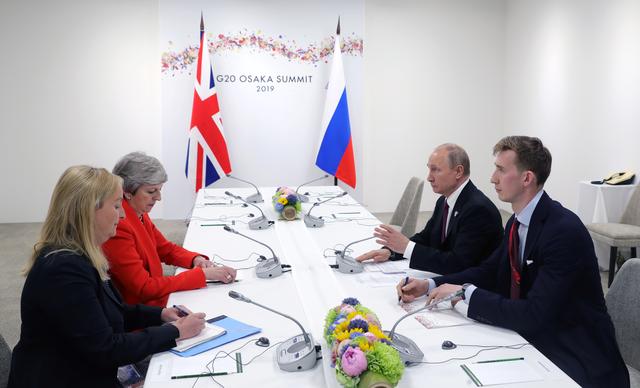
The Kremlin said on Friday that British Prime Minister Theresa May raised the poisoning of a former Russian spy on British soil at talks with Vladimir Putin and that the Russian president provided her with the relevant answers.
Putin: Meeting with British PM could be step to moving past Skripal row
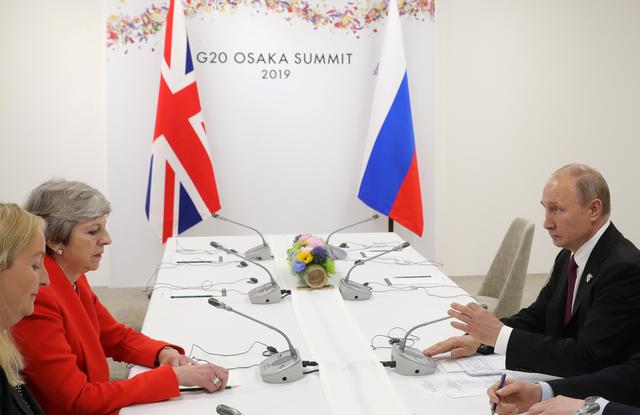
Russian President Vladimir Putin said in a published interview he believed his meeting with Britain's Theresa May at the G20 summit this week could help repair relations after the poisoning of a former Russian spy on British soil.
UK PM May tells Putin to stop destabilizing activities: spokeswoman
Prime Minister Theresa May told President Vladimir Putin on Friday that their countries can only have a different relationship if Russia stops the behavior that threatens to undermine international security, her spokeswoman said.
Kremlin says Putin answered UK PM May's questions on spy poisoning
The Kremlin said on Friday that British Prime Minister Theresa May raised the poisoning of a former Russian spy on British soil at talks with Vladimir Putin and that the Russian president provided her with the relevant answers.
Putin: Meeting with British PM could be step to moving past Skripal row
Russian President Vladimir Putin said in a published interview he believed his meeting with Britain's Theresa May at the G20 summit this week could help repair relations after the poisoning of a former Russian spy on British soil.
